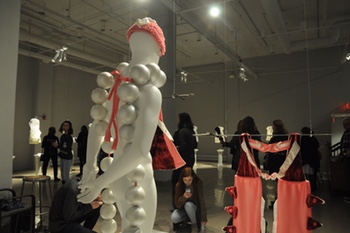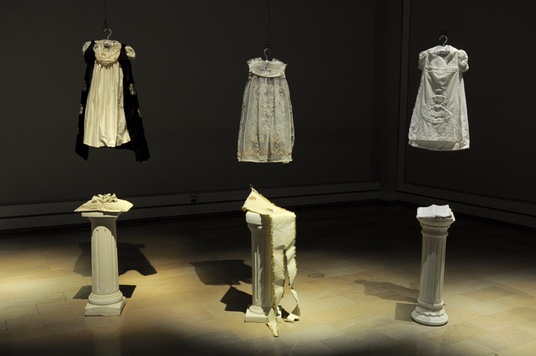Through 2/25
Almost a decade in the making, the exhibit Riparazione: Meditations on the Fullness of Being (Woman) by Cleveland artist Anne Kmieck features 11 white embroidered christening gowns hung above white pedestals displaying objects suggesting aspects of the wearers’ lives. At the Galleries at CSU, where they’re on display in the North Gallery, they’re set in a loose semi-circle and spotlight so they leap out of the surrounding darkness, an invitation to enter the worlds of the 11 women they represent.
Who are the invisible wearers of the gowns? They are historical women who lived across two millennia, starting with Mary and moving into the 20th century Catholic Workers founder Dorothy Day and African-American nun Thea Bowman. All were driven by powerful imperatives that in some respect defied the demands of the male-controlled Catholic Church and represented a change or breakthrough in spiritual practice. They include figures such as Hildegarde of Bingen, Jeanne D’arc and Angela, founder of the Ursulines, along with lesser-known figures such as Caterina of Siena and Sor Juana Inez de la Cruz.
It took Kmieck seven years to actually create the gowns; she even travelled to London to take a course at the Royal School of Needlework when she felt limited by her own skills. One look at the complex and varied needlework depicting symbols connected to the women’s lives and a viewer will quickly see why this collection took so long to execute.
“Originally it was a very simple idea,” she says. “I thought I would pull it off in six months. The first one was a sample I was making to figure out how to embroider that turned into dress. In summer 2007, I started to play around with it and then I shattered my ankle. I was out of commission with the world for 7 weeks. And it turned into a dress.”
“I love the fact that it’s a traditional women’s medium,” she adds. “I love that it marries the subject with the form.”
The seed for the show was planted during a 2005 trip to the Vatican Museum.
She recalls, “You get your ticket and you go past the Laocoön from Roman-Greco era, a man with two sons with snakes wrapped around them. You go by the fake one; then you go by the real one. Then you enter a gallery of Greco-Roman male sculptures, a forest of them in different poses. Suddenly there I was, confronted by this maleness. I don’t know what I was thinking going to the Vatican, being confronted by it. I had such a repulsive reaction to it.”
In any case, it got her thinking about the under-recognized contributions women had made to the church across centuries.
Initially, she said, “This was going to be simply refutation of document that came out in the ’90s trying to quash discussion of women in the priesthood. I think it was about within a year of Beijing conference on women, and Catholic women found each other from all over the world. They realized that women who felt called to the priesthood wasn’t a first-world thing. It was women all over the world. Probably the seeds go back to that.”
She says that the choice of the 11 women emerged gradually during the process of creation, as she studied and explored history.
“I did my own research, but those names were out there,” she says. “These women all stepped out of their roles as wife and mother and were agents in the world, and their ideas and works were documented. It shows the brilliance of women throughout history. Most women throughout history never got documented. But women were thinkers and problem solvers, and had this huge imagination.”
The exhibit also includes an installation called Aggiornamento (which means “bringing up to date”) that brings the feminine to bear on the masculine. It features a male mannequin swathed in giant pearl beads and a pink hat (no, not a pussy hat —it’s actually crafted from an old bathing cap of her mother’s), facing stylized silver, white and pink undergarments lined with velvet, representing the opportunity for the male to assume some of the aspects of womanhood. They hang on swords, which play with ideas of both vulnerability and armor. The installation stands on a platform covered with pearlescent tiles on which visitors can write quotes evoked by their feelings about the show.
“Men in power have a lot to say about what women should say or do, but I wanted to give then opportunity to luxuriate in what it feels like to be a woman,” Anne explains.
The Galleries at CSU are open Tuesday-Thursday @ noon-5pm, Friday-Saturday @ noon-7pm. The show remains on view through Sat 2/25.

Cleveland, OH 44115
